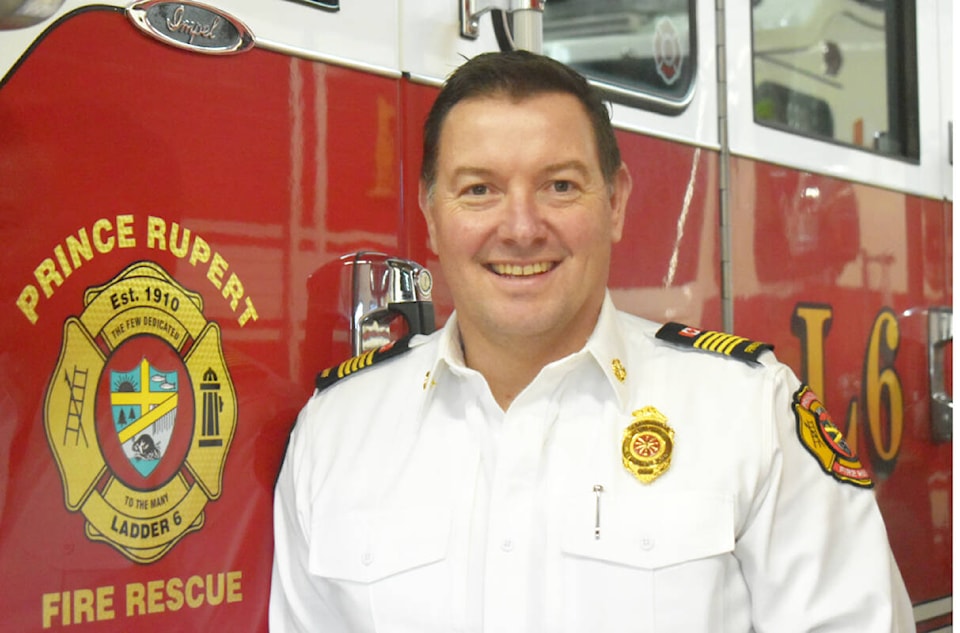Prince Rupert Fire Rescue has been triggered by the 143 emergency calls received in July to change how they respond to calls, Fire Chief Jeff Beckwith presented to the city council on Aug. 22.
The majority of those calls were not fire-related, with only 16 being fire calls, 185 ambulance calls and 156 for other emergency services, he stated in a report at the regular council meeting.
The ongoing challenges with BC Ambulance staffing are creating a strain on emergency services in the city. Beckwith stated in July the department was “stretched thin with multiple non-critical medical incidents,” citing numerous medical calls at the same time as a residential fire requiring the call-in of additional firefighters.
Moving forward the fire department will only respond to purple calls from BC Ambulance Service’s (BCAS) dispatch.
This will reduce the amount of overtime for responding to medical incidents, Beckwith wrote. In July there were 68 medical incidents resulting in overtime from firefighters needing to drive ambulances and/or delays on the scene.
Purple calls are BC Emergency Health Service’s (BCEHS) highest priority and refer to any immediately life-threatening situation, such as cardiac arrest, according to a document published by BCEHS in June 2018.
Red calls are second in line in terms of priority and refer to immediately life-threatening or time-critical situations, such as chest pain. The colours continue to decrease in urgency after red to include situations that are potentially serious but not immediately life-threatening and those that are non-urgent.
One of the 16 fire-specific calls the PRFR responded to in July and partly prompted the change, was a residential fire causing $15,000 worth of damages, Beckwith reported.
“The fire was quickly extinguished by call back crews that were staged at the fire station, but these events were the catalyst to initiate changes to the types and frequency of medical incidents that the department responds to.”
During the Aug. 22 council meeting, Beckwith asked for the city to take proactive steps toward fire prevention by adopting a new bylaw requiring a schedule of fire inspections for city buildings.
Currently, the City of Prince Rupert doesn’t have a regular fire inspection policy, he stated.
The bylaw would outline the frequency of fire inspections for commercial, industrial and other public buildings but would not include personal residential properties.
“While the responsibility to maintain a compliant property remains with the owner or property representative, the municipality is legislated to conduct inspections to confirm these requirements are completed and that life safety needs are met,” Beckwith stated.
The fire department has been doing the inspections for many years but it has never been defined by the municipality.
A proposed schedule assigned buildings a classification under the BC Building Code with an accompanying inspection frequency.
For example, theatres, churches, nightclubs, schools and arenas all corresponded with an inspection frequency of one year. Mercantiles were proposed an inspection frequency of two years. These time frames were based on other communities of similar demographics and size, as well as trends reported to him by the BC Fire Marshall, Beckwith said.
Section 26 of the BC Fire Services Act requires municipalities to provide a regular system of fire inspections of buildings within their jurisdiction, Beckwith wrote.
He recommended that council adopt the schedule he proposed, which defined the inspection schedule. Council members agreed to have to staff draft an amendment to the Fire Control and Protection Bylaw.
During July the fire department conducted 10 public building inspections. In 2019, they conducted 138 inspections in the same month and in 2018 they conducted 115 inspections. In 2021 they conducted zero inspections.
With files from K-J Millar
READ MORE: BC Ambulance needs to step up so Prince Rupert firefighters can step back – City Council
Kaitlyn Bailey | Local Journalism Initiative Reporter
Send Kaitlyn email
Send The Observer email
Like the The Northern View on Facebook
Follow us on Twitter
